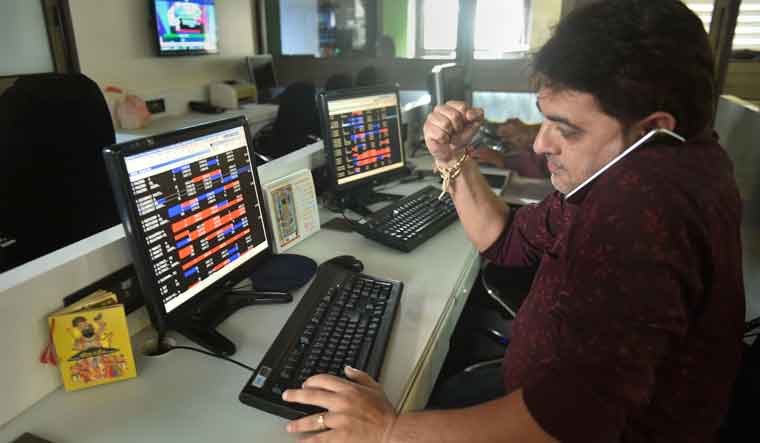Broader equity markets surged on Wednesday morning with the BSE Sensex and NSE Nifty 50 up close to 3 per cent in morning trades as investors gave a thumbs up to Prime Minister Narendra Modi’s announcement of Rs 20 lakh crore economic stimulus package to revive the economy hit by the COVID-19 pandemic and the nationwide lockdown. However, the specific details are yet to be announced and that is what the investors will be closely watching out for and key to sustaining the market enthusiasm.
After closing at 31,371.12 on Tuesday, the benchmark Sensex opened at 32,841.87 points, up 1,470 points. However by 9.30am it had given up half of its gains. At 10:00am, Sensex was trading at 32,062.25, up 691 points or 2.2 per cent. Similarly, the Nifty 50 was up 191 points or 2.10 per cent at 9,387.90 level.
Banking stocks were among the big gainers in morning trade, with ICICI Bank gaining more than 5 per cent and HDFC Bank also up over 4 per cent. Other banking and finance stocks like Axis Bank, State Bank of India, Kotak Mahindra Bank and Bajaj Finance also rose 3-4 per cent.
Auto stocks were the other major gainers; Hero MotoCorp, Mahindra & Mahindra, Maruti Suzuki and Bajaj Auto accelerated 3-5 per cent.
Larsen & Toubro, Ultratech Cement, Power Grid, NTPC, Titan and Tata Steel were some of the other gainers.
In his address to the nation on Tuesday night, Prime Minister Modi announced a Rs 20 lakh crore economic package, details of which will be announced by Finance Minister Nirmala Sitharaman over the next few days starting Wednesday. He stressed that the package laid emphasis on land, labour, liquidity and laws and will be targeting the labourers, farmers, tax payers and micro, small and medium enterprises.
The government, which had earlier announced a Rs 1.7 lakh crore welfare stimulus for the poor, had been criticised for not doing more. In that context, the package announced by the prime minister will be huge, accounting for 10 per cent of India’s GDP. But, what also must be remembered is that it will also include the earlier government stimulus as well as the various monetary steps announced by the Reserve Bank of India (RBI).
“The headline stimulus number is ahead of market’s expectations, but we await details to discern its ability to drive a quicker growth recovery than our expectations,” said Tanvee Gupta Jain, economist at investment bank UBS.
Since the COVID-19 outbreak, the RBI has announced several monetary measures to infuse liquidity, including targeted long-term repo operations (TLTROs) and special liquidity facility for mutual funds. The government also announced a few measures for the MSMEs apart from the welfare package for the poor.
The combined government and RBI support announced till date has been to the tune of Rs 7 lakh crore, or 3.4 per cent of GDP, and the remaining Rs 13 lakh crore (6.2 per cent of GDP) is now the policy space left, Jain pointed out.
Mahesh Nandurkar, equity strategist at foreign brokerage firm Jefferies said the headline number of the fiscal package was “impressive,” but a lot would depend on the details, which the finance minister will announce.
“The incremental announcements values are also likely to be a gross number, i.e., there will be items such as expenditure reallocations, credit guarantee schemes and possibly more measures from the RBI,” said Nandurkar.
Suman Chowdhury, chief analytical officer at Acuite Ratings and Research said it would be important to figure out the financing methods as large additional government borrowings from any of the sources will have implications on not just fiscal position, but other macro indicators like inflation.
“Nevertheless, the announcement goes beyond a particular stimulus amount and reflects the government’s intent to alter the economic narrative through substantial reforms that will facilitate large scale private and public sector investments towards Make in India and infrastructure projects, thereby generating employment opportunities,” said Chowdhury.



